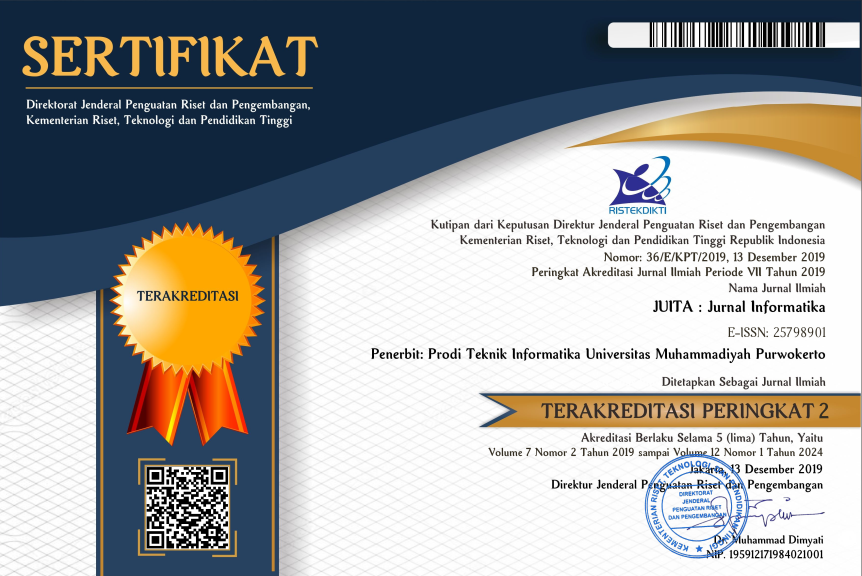Sentiment Analysis of Student Comment on the College Performance Evaluation Questionnaire Using Naïve Bayes and IndoBERT
DOI:
https://doi.org/10.30595/juita.v11i2.17336Keywords:
Classification, sentiment analysis, college evaluation, IndoBERT, Naïve BayesAbstract
The development of the Internet has played a significant role in various aspects of life and has generated vast amounts of data, including student comments about universities. The challenge in analyzing comment data is the large number of students providing feedback, which makes manual analysis impractical. The purpose of this study is to analyze the performance evaluation of universities by students in terms of positive and negative sentiments, with the aim of assessing the level of student satisfaction with all elements and areas of university operations. This research utilized the Naïve Bayes algorithm and the IndoBERT model to build a classification model based on questionnaire data, starting from the data collection process, data preprocessing, feature extraction, modeling, and evaluation. The results of the IndoBERT model demonstrated the best performance, with an accuracy of 85%. The IndoBERT model effectively recognizes sentiments in text, distinguishing between positive and negative comments regarding university performance.References
[1] A. Zein, S. Farizy, and E. Suharyanto, “Sentimen Analisis Pada Komentar Pendek Evaluasi Dosen Oleh Mahasiswa (Edom) Program Studi Sistem Informasi Universitas Pamulung,” J. Ilmu Komput., vol. 5, no. 01, pp. 17–23, 2022, [Online]. Available: https://jurnal.pranataindonesia.ac.id/index.php/jik/article/view/113%0Ahttps://jurnal.pranataindonesia.ac.id/index.php/jik/article/download/113/66
[2] M. A. Amrustian, W. Widayat, and A. M. Wirawan, “Analisis Sentimen Evaluasi Terhadap Pengajaran Dosen di Perguruan Tinggi Menggunakan Metode LSTM,” J. Media Inform. Budidarma, vol. 6, no. 1, pp. 535–541, 2022, doi: 10.30865/mib.v6i1.3527.
[3] W. Parasati, F. A. Bachtiar, and N. Y. Setiawan, “Analisis Sentimen Berbasis Aspek pada Ulasan Pelanggan Restoran Bakso President Malang dengan Metode Naïve Bayes Classifier,” J. Pengemb. Teknol. Inf. dan Ilmu Komput., vol. 4, no. 4, pp. 1090–1099, 2020.
[4] D. Normawati and S. A. Prayogi, “Implementasi Naïve Bayes Classifier Dan Confusion Matrix Pada Analisis Sentimen Berbasis Teks Pada Twitter,” J. Sains Komput. Inform., vol. 5, no. 2, pp. 697–711, 2021.
[5] T. Chandra Harita, R. Kridalukmana, and D. Eridani, “Pengembangan Aplikasi Analisis Sentimen Terhadap Brand Berbasis Web Menggunakan Kerangka Kerja Flask Web-Based Sentiment Analysis Application Development Using Flask Framework,” J. Tek. Komput., vol. 1, no. 2, pp. 36–40, 2022, doi: 10.14710/jtk.v1i2.36307.
[6] N. Mahfudiyah and A. Alamsyah, “Analisis Persepsi Konsumen Terhadap Kualitas Layanan Gojek Menggunakan Sentiment Analysis Dan Topic Modeling Berdasarkan Deep Learning IndoBERT,” e-Proceeding Manag., vol. 9, no. 4, pp. 1812–1817, 2022.
[7] Z. Munawar, Iswanto, D. Widhiantoro, and N. I. Putri, “Analisis Sentimen Covid-19 Pada Media Sosial Dengan Model Neural Machine Translation Analysis of Covid-19 Sentiment on Social Media with Neural Machine Translation Model,” Temat. J. Teknol. Inf. Komun., vol. 5, no. 1, pp. 15–20, 2022.
[8] R. Naquitasia, D. H. Fudholi, and L. Iswari, “ANALISIS SENTIMEN BERBASIS ASPEK PADA WISATA HALAL DENGAN METODE DEEP LEARNING,” J. TEKNOINFO, vol. 16, no. 2, pp. 156–164, 2022.
[9] S. M. Chamzah, M. Lestandy, N. Kasan, and A. Nugraha, “Penerapan Synthetic Minority Oversampling Technique ( SMOTE ) untuk Imbalance Class pada Data Text Menggunakan KNN,” Syntax J. Inform., vol. 11, no. 02, pp. 56–67, 2022.
[10] M. Syarifuddin, “Analysis of Public Opinion Sentiment Regarding Covid-19 on Twitter Using the Naïve Bayes and Knn Method,” Inti Nusa Mandiri, vol. 15, no. 1, pp. 23–28, 2020.
[11] I. T. Julianto, “Analisis Sentimen Terhadap Sistem Informasi Akademik Mahasiswa Institut Teknologi Garut,” J. Algoritm., vol. 19, no. 1, pp. 458–465, 2022.
[12] A. P. Giovani, A. Ardiansyah, T. Haryanti, L. Kurniawati, and W. Gata, “Analisis Sentimen Aplikasi Ruang Guru Di Twitter Menggunakan Algoritma Klasifikasi,” J. Teknoinfo, vol. 14, no. 2, p. 115, 2020, doi: 10.33365/jti.v14i2.679.
[13] C. H. Yutika, A. Adiwijaya, and S. Al Faraby, “Analisis Sentimen Berbasis Aspek pada Review Female Daily Menggunakan TF-IDF dan Naïve Bayes,” J. Media Inform. Budidarma, vol. 5, no. 2, p. 422, 2021, doi: 10.30865/mib.v5i2.2845.
[14] M. Ma’ruf, A. P. Kuncoro, P. Subarkah, and F. Nida, “Sentiment analysis of customer satisfaction levels on smartphone products using Ensemble Learning,” Ilk. J. Ilm., vol. 14, no. 3, pp. 339–347, 2022, doi: http://dx.doi.org/10.33096/ilkom.v14i3.1377.339-347.
[15] D. F. Zhafira, B. Rahayudi, and Indriati, “ANALISIS SENTIMEN KEBIJAKAN KAMPUS MERDEKA MENGGUNAKAN NAIVE BAYES DAN PEMBOBOTAN TF-IDF SENTIMENT ANLAYSIS OF KAMPUS MERDEKA POLICY USING NAIVE BAYES AND TF-IDF TERM WEIGHTING BASED ON YOUTUBE,” J. Sist. Informasi, Teknol. Informasi, dan Edukasi Sist. Inf., vol. 2, no. 1, pp. 55–63, 2021.
[16] L. R. Dharmawan, I. Arwani, and D. E. Ratnawati, “Analisis Sentimen pada Sosial Media Twitter Terhadap Layanan Sistem Informasi Akademik Mahasiswa Universitas Brawijaya dengan Metode K- Nearest Neighbor,” J. Pengemb. Teknol. Inf. dan Ilmu Komput., vol. 4, no. 3, pp. 959–965, 2020.
[17] B. Wilie et al., “IndoNLU: Benchmark and Resources for Evaluating Indonesian Natural Language Understanding,” CoRR, vol. abs/2009.0, 2020, [Online]. Available: https://arxiv.org/abs/2009.05387
[18] S. M. Isa, G. Nico, and M. Permana, “Indobert for Indonesian Fake News Detection,” ICIC Express Lett., vol. 16, no. 3, pp. 289–297, 2022, doi: 10.24507/icicel.16.03.289.
[19] H. Jayadianti, W. Kaswidjanti, A. T. Utomo, S. Saifullah, F. A. Dwiyanto, and R. Drezewski, “Sentiment analysis of Indonesian reviews using fine-tuning IndoBERT and R-CNN,” Ilk. J. Ilm., vol. 14, no. 3, pp. 348–354, 2022, [Online]. Available: http://dx.doi.org/10.33096/ilkom.v14i3.1505.348-354
[20] T. I. Z. M. Putra, Suprapto, and A. F. Bukhori, “Model Klasifikasi Berbasis Multiclass Classification dengan Kombinasi Indobert Embedding dan Long Short-Term Memory untuk Tweet Berbahasa Indonesia (Classification Model Based on Multiclass Classification with a Combination of Indobert Embedding and Long,” J. Ilmu Siber dan Teknol. Digit., vol. 1, no. 1, pp. 1–28, 2022, [Online]. Available: https://doi.org/10.35912/jisted.v1i1.1509
Downloads
Published
How to Cite
Issue
Section
License

JUITA: Jurnal Informatika is licensed under a Creative Commons Attribution 4.0 International License.
















